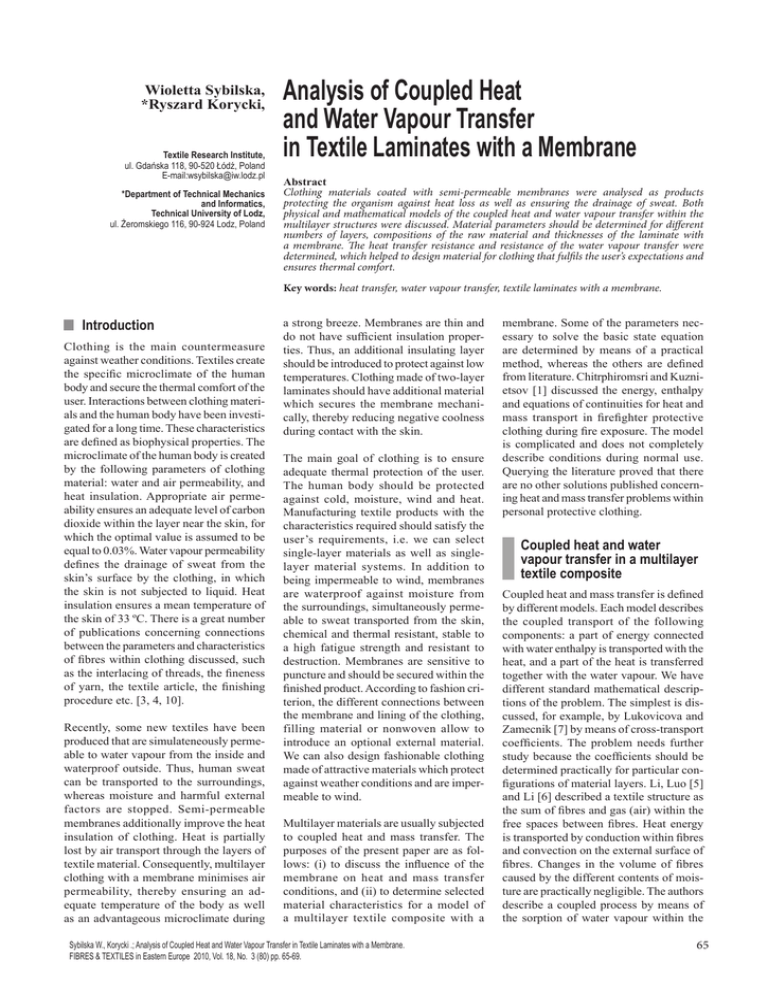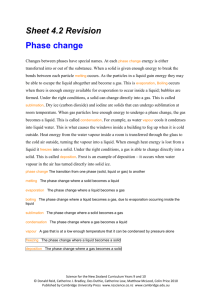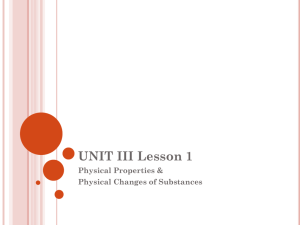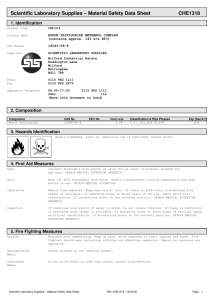Analysis of Coupled Heat and Water Vapour Transfer Wioletta Sybilska,
advertisement

Wioletta Sybilska, *Ryszard Korycki, Textile Research Institute, ul. Gdańska 118, 90-520 Łódź, Poland E-mail:wsybilska@iw.lodz.pl *Department of Technical Mechanics and Informatics, Technical University of Lodz, ul. Żeromskiego 116, 90-924 Lodz, Poland Analysis of Coupled Heat and Water Vapour Transfer in Textile Laminates with a Membrane Abstract Clothing materials coated with semi-permeable membranes were analysed as products protecting the organism against heat loss as well as ensuring the drainage of sweat. Both physical and mathematical models of the coupled heat and water vapour transfer within the multilayer structures were discussed. Material parameters should be determined for different numbers of layers, compositions of the raw material and thicknesses of the laminate with a membrane. The heat transfer resistance and resistance of the water vapour transfer were determined, which helped to design material for clothing that fulfils the user’s expectations and ensures thermal comfort. Key words: heat transfer, water vapour transfer, textile laminates with a membrane. n Introduction Clothing is the main countermeasure against weather conditions. Textiles create the specific microclimate of the human body and secure the thermal comfort of the user. Interactions between clothing materials and the human body have been investigated for a long time. These characteristics are defined as biophysical properties. The microclimate of the human body is created by the following parameters of clothing material: water and air permeability, and heat insulation. Appropriate air permeability ensures an adequate level of carbon dioxide within the layer near the skin, for which the optimal value is assumed to be equal to 0.03%. Water vapour permeability defines the drainage of sweat from the skin’s surface by the clothing, in which the skin is not subjected to liquid. Heat insulation ensures a mean temperature of the skin of 33 ºC. There is a great number of publications concerning connections between the parameters and characteristics of fibres within clothing discussed, such as the interlacing of threads, the fineness of yarn, the textile article, the finishing procedure etc. [3, 4, 10]. Recently, some new textiles have been produced that are simulateneously permeable to water vapour from the inside and waterproof outside. Thus, human sweat can be transported to the surroundings, whereas moisture and harmful external factors are stopped. Semi-permeable membranes additionally improve the heat insulation of clothing. Heat is partially lost by air transport through the layers of textile material. Consequently, multilayer clothing with a membrane minimises air permeability, thereby ensuring an adequate temperature of the body as well as an advantageous microclimate during a strong breeze. Membranes are thin and do not have sufficient insulation properties. Thus, an additional insulating layer should be introduced to protect against low temperatures. Clothing made of two-layer laminates should have additional material which secures the membrane mechanically, thereby reducing negative coolness during contact with the skin. The main goal of clothing is to ensure adequate thermal protection of the user. The human body should be protected against cold, moisture, wind and heat. Manufacturing textile products with the characteristics required should satisfy the user’s requirements, i.e. we can select single-layer materials as well as singlelayer material systems. In addition to being impermeable to wind, membranes are waterproof against moisture from the surroundings, simultaneously permeable to sweat transported from the skin, chemical and thermal resistant, stable to a high fatigue strength and resistant to destruction. Membranes are sensitive to puncture and should be secured within the finished product. According to fashion criterion, the different connections between the membrane and lining of the clothing, filling material or nonwoven allow to introduce an optional external material. We can also design fashionable clothing made of attractive materials which protect against weather conditions and are impermeable to wind. Multilayer materials are usually subjected to coupled heat and mass transfer. The purposes of the present paper are as follows: (i) to discuss the influence of the membrane on heat and mass transfer conditions, and (ii) to determine selected material characteristics for a model of a multilayer textile composite with a Sybilska W., Korycki .; Analysis of Coupled Heat and Water Vapour Transfer in Textile Laminates with a Membrane. FIBRES & TEXTILES in Eastern Europe 2010, Vol. 18, No. 3 (80) pp. 65-69. membrane. Some of the parameters necessary to solve the basic state equation are determined by means of a practical method, whereas the others are defined from literature. Chitrphiromsri and Kuznietsov [1] discussed the energy, enthalpy and equations of continuities for heat and mass transport in firefighter protective clothing during fire exposure. The model is complicated and does not completely describe conditions during normal use. Querying the literature proved that there are no other solutions published concerning heat and mass transfer problems within personal protective clothing. Coupled heat and water vapour transfer in a multilayer textile composite Coupled heat and mass transfer is defined by different models. Each model describes the coupled transport of the following components: a part of energy connected with water enthalpy is transported with the heat, and a part of the heat is transferred together with the water vapour. We have different standard mathematical descriptions of the problem. The simplest is discussed, for example, by Lukovicova and Zamecnik [7] by means of cross-transport coefficients. The problem needs further study because the coefficients should be determined practically for particular configurations of material layers. Li, Luo [5] and Li [6] described a textile structure as the sum of fibres and gas (air) within the free spaces between fibres. Heat energy is transported by conduction within fibres and convection on the external surface of fibres. Changes in the volume of fibres caused by the different contents of moisture are practically negligible. The authors describe a coupled process by means of the sorption of water vapour within the 65 material of fibres and desorption into the λw - the heat sorption of water vapour by void interfibre spaces. Additionally, fibre fibres, and orientation within the material plays a c - the volumetric heat capacity of the minimum role during the mass transport. fabric. The fibres have a small diameter, and water vapour can travel more rapidly within The state equations above contain three the void interfibre spaces as within the state variables: T, wa, and wf,but only fibre material. We can also introduce el- two correlations. The third equation can ementary thermodynamic equilibrium be- have different forms, but according to tween the fibre material and the gas within David and Nordon [2] textile structures the interfibre spaces during the process. are usually described by the experimental Heat and water vapour are transported in correlation for the i-th material layer one direction only: from the human skin 1 dw fi to the surroundings, due to the membrane e i dt being semi-permeable. Thus, the model (2) can be described in a micro scale as a (i ) 1 dw f 1D problem. The state equations within = H (ai ) − H (fi ) k 1(i ) 1 − exp k (2i ) H (ai ) − H (fi ) each layer are second-order differential å(i ) dt correlations with respect to coordinate x where: and a first-order differential correlation Ha - the relative humidity of the air, with respect to time. We can introduce Hf - the relative humidity of fibres, and the following description for the i-th layer k1 and k2- adjustable parameters predicted or evaluated by comparing i i h ai e i d 2 w ai i dw a i dw f the model and the mass of the e 1 e i ; dt dt z dx 2 fabric measured. (1) dT i dw fi d 2T i We can now assume that the results are c i lwi li ; dt dt dx 2 the same for the theoretical model and practical investigations, hence k1 = k2 = 1, where: wa - the water vapour concentration in the cf. Li [6]. air filling the interfibre void space, wf - the water vapor concentration in the The state equations should be accompanied by a set of boundary and initial fibres, conditions. Typical clothing comes into ε - the porosity of the fabric, contact with the skin through a thin air t - the real time, ha - the diffusion coefficient of water layer of prescribed values of temperature and water vapour concentration. This part vapor in the air, ζ - the effective tortuousness of the of boundary Γ1 and ΓT for coordinate x = 0 is subjected to first-kind boundary fabric, conditions. The external surface Γ3 and T - the temperature, λ - the thermal conductivity of the fabric, ΓC for coordinate x = L is not isolated, and the heat as well as water vapour are transported to the surroundings by convection. Initial conditions describe the initial distribution of state parameters within the structure. The problem can be described as follows ) [ ( T x =0 = T 0 The coupled transfer on the internal boundaries is described by fourth-kind boundary conditions. Thus, the heat and mass flux densities are the same on the common surface of the adjacent layers (i) and (i+1). i i +1 q layer = q layer x ∈ Γw ; n n layer i layer i +1 q nw = q nw x ∈ Γ4 ; nw nw (4) The membrane is relatively thin, and its effect can be described semi-analytically by a decrease in the state variables within the membrane material. The problem should be discussed in depth with reference to tests results. Additionally, the equations discussed contain some material parameters necessary to determine the right solution. n Test stand Heat resistance and resistance to the permeability of water vapor were determined by means of the ’skin’ model of M259B made by SDL International, Great Britain. The device is equipped with a “sweating guarded hotplate”, described as the “skin model plate”, which simulates the coupled emission of heat and water vapour from the skin, cf. Figure 1. The test sample is situated on the electrically heated plate, whereas the flux of conditioned air is directed parallel to its upper surface. The heat resistance Rct is determined for constant climatic conditions: temperature of the surface plate Tm = 308.15 K, air temperature within the air-conditioned channel Ta = 293.15 K, relative humidity of the air Ha = 65%, and air flow velocity va = 1 m/s. The resistance to the permeT x =0 = T 0 x ∈ ΓT ; w f x =0 = w 0f ability x ∈ Γof 1 ; water vapour R et was determined for the following parameters: temx ∈ ΓT ; w f x =0 = w 0f x ∈ Γ1 ; perature of both the surface plate and air Tm = Ta = 308.15 K, relative humidity of dT the air Ha = 40%, and the air flow velocity q n le h T x L T x C ; dx x L va = 1 m/s. dw f dx x L − w∞ ) e q nw lw E Figure 1. Skin model with the control of temperature and water supply; dw q nwmodel = ëw å 1 - sweating guarded hotplate (skin dx plate), 2 - temperature sensor, 3 - thermoregulator, 4 - thermal power control device, 5 - water dispenser device, 6 - metal block with heating element, Tm –temperature of measuring unit. 66 )] ( where: h - the heat convection coefficient, hw - the mass convection coefficient, T∞ - the surrounding temperature, and w∞ - the water vapour concentration of the surroundings. ( f x =L = −h w w f x =L x ∈ Γ3 T(x,0) = T0; wa(x,0) = wa0; wf(x,0) = wf(w∞,T0) (3) The heat resistance Rct can be defined as follows Rcctt = (Tm − Ta ) ⋅ A H − ∆H c − Rcto , in m2K/W, (5) where: Tm - the temperature of the sweating guarded hotplate, FIBRES & TEXTILES in Eastern Europe 2010, Vol. 18, No. 3 (80) Ta - the air temperature within the channel, H - the applied power of the sweating guarded hotplate, ΔHc - the correctional constant of the applied power of the sweating guarded hotplate, Rcto - the device constant, and A - the surface of the sweating guarded hotplate. Table 1. Characteristics of different clothing materials with semi-permeable membranes. Notation Rear side Weave (external fabrics) Material composition Outside Membrane Surface mass Thickness ·10-3 kg/m2 ·10-2 m A2 PES – 100% PES – 100% - twill 165 0.40 B2 PES – 100% PES – 100% - twill 145 0.29 C2 PES - 30% CO – 70% PU – 100% - twill 220 0.54 0.47 D2 PES – 100% PU – 100% - twill 160 E3 PES – 100% PU – 100% PES – 100% plain 400 2.82 F3 PES – 100% PU – 100% PES – 100% plain 380 2.64 G3 PES – 100% PU – 100% PES – 100% - 420 3.53 H3 PES – 100% PES – 100% PES – 100% twill 448 2.42 I3 PES – 100% PU – 100% PES – 100% plain 330 2.17 J3 PES – 100% PTFE – 100% PES – 100% plain 310 2.09 K3 PES – 100% PES – 100% PES – 100% twill 193 0.53 (6) L3 PES – 100% PU – 100% PES – 100% plain 370 2.43 where pm = 5620 Pa is the partial pressure of saturated water vapour at a temperature of 308.15 K; pa = 2250 Pa is the partial pressure of water vapour at a relative humidity of Ha = 40%; ΔHe denotes the correctional constant of thermal power during tests of the resistance to the permeability of water vapour, and Reto is the device constant. M3 PES – 70% CV – 30% PU – 100% PES – 100% plain 394 2.21 N3 PES - 100% PTFE – 100% PES – 100% plain 330 2.04 Reet t = ( p m − pTpa a ) ⋅ A H − ∆H e − Reto , in m2Pa/W, Thus, the water vapour permeability index imt can be determined as follows: imt = S . Rct/Ret, (7) where S = 60 Pa/K denotes the correctional constant. Index imt is dimensionless, and its value is within the range 0 – 1. An index equal to 0 denotes infinite resistance to the permeability of water vapour, i.e. the structure is not permeable to water vapour. An index equal to 1 has the same value for both the heat resistance and resistance to the permeability of water vapour as an air layer of identical thickness [9]. The temperature controller, including the temperature sensor of the unit, maintains a constant temperature Tm of the measuring unit to within ± 0.1 K. The heating power H is measurable by means of a power meter to within ± 2% above the whole of its usable range. According to the theoretical correlations and device accuracy given by the producer, the measuring accuracy is equal to ± 3%. The resistances to permeability of water vapour were tested in order to minimise the resistance to mass transport through the laminate. The results obtained are shown in Figure 2. FIBRES & TEXTILES in Eastern Europe 2010, Vol. 18, No. 3 (80) Minimal resistance to the permeability of water vapour was obtained for laminates N3 and J3, where a membrane made of PTFE is laminated to a woven fabric and knitted fabric of the polar type. In Figure 2 we immediately see that minimal values of the resistance to the permeability of water vapour are obtained for two-layer laminates (A2, B2, C2, D2, mean value Ret = 6.74 m2·Pa/W) and threelayer laminates: n N3, value Ret = 4.91 m2·Pa/W; n J3, value Ret = 5.98 m2·Pa/W. The laminates discussed have the most optimal characteristics of all the structures tested. The less the resistance to the permeability of water vapour, the better sweat is transported from the skin to the surroundings. The majority of laminates tested have a resistance to the permeability of water vapor = Ret ≤ 20 m2·Pa/W; only laminate G3 has Ret > 20 m2·Pa/W. Laminate G3 is of three layers; both the external and internal layers are made of polar-type fabric. Laminate G3 also represents Class 2, according to Table 2, i.e. a medium level of biophysical characteristics. All the other laminates represent Class 3, i.e. an advantegeous level of biophysical characteristics. Different resistances to the permeability of water vapour are caused by different membrane characteristics applied in textile laminates, cf. Figure 3. The membrane made of PTFE ensures minimal resistance, Clothing made of two-layer laminates should have additional material which secures the membrane mechanically, thereby 25 n Samples and test methods Samples made of Optex firm were tested. All the samples were diversified i.e. they were made of different textile raw materials, membranes, weave as well as the number and types of layers. The material characteristics are given in Table 1. The test method was determined according to [8]. reducing negative coolness during contact with the skin. n Test results and analysis Figure 2. Diagram of the monofactoral analysis of variance, the variable being the resistance to the permeability of water vapour. Water vapour resistance, m2Pa/W The resistance to the permeability of water vapour Ret can be defined by the correlation 20 15 10 5 0 A2 B2 C2 D2 E3 F3 G3 H3 I3 J3 K3 L3 M3 N3 Material 67 Table 2. Classification of the resistance to the permeability of water vapour [9]. Class 3 2 1 Ret ≤ 20 20 < Ret ≤ 40 40 < Ret 18 18 16 16 Water vapour resistance, m2Pa/W Water vapour resistance, m2Pa/W Resistance to the permeability of water vapour Ret, m2Pa/W 14 12 10 8 6 4 2 0 PU-100% PES-100% PTFE-100% Membrane Figure 3. Mean values of resistance to the permeability of water vapour for different membranes. 12 10 8 6 4 2 0 none polar knitted net Figure 4. Mean values of the resistance to the permeability of water vapour for different inner parts. Water vapour permeability index Heat resistance, m2K/W 14 0.6 0.05 0.04 0.03 0.02 0.01 0 n Conclusions Rear side 0.07 0.06 0.5 0.4 0.3 0.2 0.1 0.0 E3 F3 G3 H3 I3 J3 K3 L3 M3 N3 Material E3 F3 G3 H3 I3 J3 K3 L3 M3 N3 Material Figure 5. Diagram of the mean values of the monofactoral analysis of variance, the variable being heat resistance. Figure 6. Water vapour permeability index for different materials. whereas the that made of PU ensures maximal resistance to water vapour transport through the laminate. Thus, membranes made of PU can be uncomfortable for the user of clothing made of these materials. Let us compare the influence of the membrane on the resistance to the permeability of water vapour for laminates I3 (a membrane made of 100% PU) and J3 (a membrane made of 100% PTFE). The membranes have similar thicknesses (laminate I3 – 2.17 mm, laminate J3 – 2.09 mm) but absolutely different resistances to the permeability of water vapour (laminate I3 – 18.65 m2Pa/W, laminate J3 – 5.98 m2Pa/W). in contact with the body. To reduce the negative sensation, the finished product needs an additional layer of material (a lining of clothing). As regards the tests results, there is a heavy influence of the material of the inner part on the resistance to the permeability of water vapour. The parameters discussed are shown in Figure 4. Two-layer laminates with the inside made of a membrane have a minimal value of the mean resistance to the permeability of water vapour. Thus, these materials have a minimal resistance to mass transport through the laminate. The main disadvantage is the negative feeling of cold caused by the membrane 68 A penetration index equal to 1 indicates the material has a heat resistance and resistance to the permeability of water vapour equivalent to an air layer of the same thickness. The values of heat resistance obtained for the complete textile material with a membrane and all material layers (Figure 5) are of a wide range 0.002 – 0.063 m2K/W for the laminates tested. The difference is caused by the different thicknesses of the laminate. The bigger the thickness of the laminate (laminates E3 and G3 have the biggest), the higher the heat resistance (i.e. protection against cold). The heat isolator is optimised by changes in the thickness of the laminate. The protective clothing should be relatively light, which improves user comfort. Laminate K3 has the minimal heat resistance of the materials tested. Thus, this laminate has minimal thickness, which suggests the linear dependence of heat resistance on the thickness. A water vapor permeability index (Figure 6) equal to zero indicates that the material is impermeable to water vapor. The most important conditions defined for outer materials are effective protection against low temperatures and rainfall, as well as moisture transport from the skin. From the tests the following may be concluded: n Laminates equipped with a membrane made of PTFE have minimal resistance to mass transport. A membrane made of PU ensures maximal resistance to mass transport through the laminate, which can cause user discomfort. n A major part of the laminates are the 3 class materials, i.e. they have good biophysical properties. Only laminate G3 is a 2 class material, i.e. it has a “medium level” of the properties discussed. n The three-layer laminate G3 has the best heat-insulating properties; it has a different structure made up of three layers. The outer and inner sides are made of polar, and its thickness is maximal. n Of the three-layer laminates, laminate K3 of minimal thickness has minimal heat insulation. Thus, the physiological properties of three-layer material are created by all material layers of the structure. The protective function required as well as satisfactory physiological properties are determined within the finished products by the accurate selection of textile materials. Summarising the practical considerations, we can formulate the following theoretical conclusions concerning coupled heat and water vapour transfer within membrane structures. n The coupled transport through semipermeable membranes is difficult to model for multilayer structures. The perfect membrane ensures the complete transport of moisture and heat from the skin to the surroundings. Heat and water vapor are not transported from the surroundings to the human body as they are stopped by the membrane. Heat resistance and resistance to the permeability of water vapour are not tested for membranes within the material. Thus, the membrane effect can be FIBRES & TEXTILES in Eastern Europe 2010, Vol. 18, No. 3 (80) determined practically for a material of negligible thickness. n Correct physical and mathematical models of the membrane should be determined from tests of existing structures. The membrane material should have the prescribed properties of heat and water vapour transport as well as negligible thickness. A new theoretical model of the multilayer membrane structure will be introduced in the second part of the paper, which is now in preparation. The model presented can be used to shape the optimisation of structures subjected to coupled transport. References 1. Chitrphiromsri, P., Kuznietsov, A.V.; Modeling heat and moisture transport in firefighter protective clothing during flash fire exposure, Heat and Mass Transfer, publication online, 10.1007/s00231-0040504-x, 2004. 2. David H. G., Nordon P.; Case studies of coupled heat and moisture diffusion in wool beds, Textile Research Journal, Vol. 39, (1969) pp. 166-172. 3. Lamb G. E. R.; Heat and Water Vapor Transport In Fabrics Under Ventilated Conditions, Text. Res. J., Vol. 62, No. 7 (1992). 4. Le C. V., Ly N. G.; Heat and Moisture Transfer In Textile Assemblies, Part I: Steaming of Wool, Cotton, Nylon and Poliester Fabric Beds, Text. Res. J. Vol. 65 No. 4. (1995). 5. Li Y., Luo Z.; An improved mathematical simulation of the coupled diffusion of moisture and heat in wool fabric, Textile Research Journal, Vol. 69, No. 10, (1999) pp. 760-768. 6. Li Y., The science of clothing comfort, Textile Progress, Vol. 31, No. 1/2, 2001. 7. Lukovicova J., Zamecnik J.; Determination of cross-coupled coefficients for coupled heat and mass transfer in porous media, internet publication. 8. PN-EN 31092: 1998/Ap1:2004 Textiles – Determination of physiological properties – Measurement of thermal and water-vapour resistance under steady – state conditions (sweating guarded – hotplate test). 9. PN-EN 343: 2006 + A1:2007, Protective clothing - Protection against rain. 10. Zieliński J.; Transport of steam and water through multilayer fabrics in clothing, Prz. Włók. Tech. Włók. 4/2002, pp 13-16. Received 22.09.2008 , Instytut Biopolimerów i Włókien Chemicznych Institute of Biopolymers and Chemical Fibres Multifilament Chitosan Yarn The Institute of Bioploymers and Chemical Fibres is in possession of the know- how and equipment to start the production of continuous chitosan fibres on an extended lab scale. The Institute is highly experienced in the wet – spinning of polysaccharides, especially chitosan. The Fibres from Natural Polymers department, run by Dr Dariusz Wawro, has elaborated a proprietary environmently-friendly method of producing continuous chitosan fibres with bobbins wound on in a form suitable for textile processing and medical application. Multifilament chitosan yarn We are ready, in cooperation with our customers, to conduct investigations aimed at the preparation of staple and continuous chitosan fibres tailored to specific needs in preparing non-woven and knit fabrics. We presently offer a number of chitosan yarns with a variety of mechanical properties, and with single filaments in the range of 3.0 to 6.0 dtex. The fibres offer new potential uses in medical products like dressing, implants and cell growth media. Instytut Biopolimerów i Włókien Chemicznych ul. Skłodowskiej-Curie 19/27; 90-570 Łódź, Poland; Phone: (48-42) 638-03-02, Fax: (48-42) 637-65-01 E-mail: ibwch@ibwch.lodz.pl http://www.ibwch.lodz.pl Reviewed 06.10.2009 FIBRES & TEXTILES in Eastern Europe 2010, Vol. 18, No. 3 (80) 69







